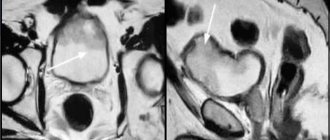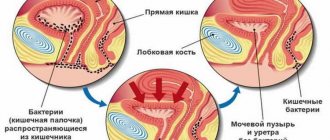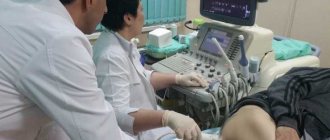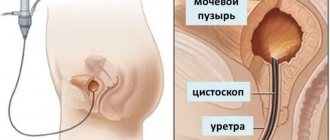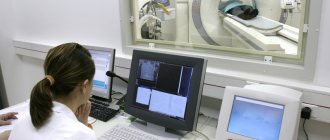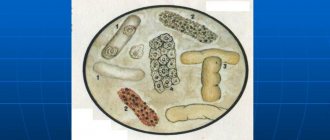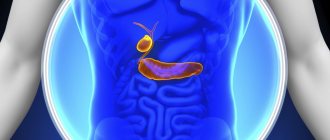X-ray (cystography) of the bladder is an X-ray, non-invasive diagnosis that is carried out to identify pathological changes in the genitourinary system. The procedure is prescribed for both adults and children. An X-ray examination is done using a contrast agent, which allows one to study the integrity, condition and structure of the organ being examined. As a result of the study, it is possible to identify serious diseases, make an accurate diagnosis and begin immediate treatment.
Methods for diagnosing the bladder
To make a diagnosis, when symptoms of inflammation of the genitourinary system appear, an x-ray of the kidneys and bladder, or cystography, is performed. There are several methods of X-ray diagnostics:
- Survey. This method shows the entire bladder and kidneys. The method allows you to identify sand and stones in organs.
- Excretory urography with contrast agent. Allows you to assess the performance of the urinary system. The contrast agent is removed from the body in the urine.
- Infusion is carried out similarly to excretory, the pictures are clearer.
- Retrograde ureteropyelography allows the administration of a contrast agent through the ureter through a catheter. The method allows you to see minor changes in the system.
- Antegrade pyeloureterography. The contrast agent is administered through a puncture in the lower back. Used when previous methods are unreliable.
Features of the study
Cystography is a complex procedure involving the participation of nursing staff, a urologist and a radiologist.
In the descending option, the nurse prepares the patient and injects the selected contrast agent into the vein.
Her responsibilities include identifying changes in the patient’s well-being and promptly sending him for an X-ray, which usually happens within an hour.
With ascending (retrograde) cystography, the manipulation of inserting the catheter is carried out by a doctor.
To reduce discomfort during insertion of a urethral catheter, it is lubricated with sliding medical gels, for example, Katedgel.
After contrast is injected into the bladder, the tube is clamped and the radiologist takes a series of pictures. During the diagnosis, the patient is on the table in a supine position; if necessary, the doctor asks him to turn over on his side or stomach.
When prescribing cystography, radiography is performed before the administration of a contrast agent, during filling of the bladder and after the procedure. This makes it possible to accurately identify and evaluate the nature of pathological changes.
Cystography
When X-raying the bladder with a contrast agent, a liquid or gaseous form of the solution is used. The drug is administered using a catheter. When administering contrast medication, one of the following methods is used:
- Rising. The substance is injected directly into the bladder cavity. You should first go to the toilet. The method is characterized by high reliability of the results.
- Descending. With this method, a contrast agent is administered intravenously. In this case, you will have to wait at least an hour for the colored substance to reach the bladder. For this reason, the method is not popular.
An X-ray of the bladder with a contrast agent allows you to see a clear picture of the genitourinary system, identify stones and other pathologies of the organ. X-rays also have a high degree of reliability in detecting tumors.
Iododamide, triombrast, and urografin are used as contrast agents. An excessive amount of these substances in the kidneys, 30 minutes after administration of the drug, indicates a slow functioning of the genitourinary system.
Complications
Descending cystography is most often complicated by an allergic reaction after the administration of a contrast solution. It usually develops in an immediate manner and is manifested by an increase in shortness of breath, rash and widespread urticaria.
Patients complain of choking, coughing, and the formation of red itchy blisters on the body. Little children become restless and rush around.
In order to interrupt the development of an allergic reaction and prevent its further progression, the doctor must prescribe medications - hormones are administered intravenously, antihistamines are administered intramuscularly, for example, Suprastin.
In addition to allergic changes, contrast solutions can cause a nephrotoxic effect. It manifests itself as a sharp deterioration in health, dizziness, and headaches. Patients experience an odor of acetone from the oral cavity.
Nephrotoxic syndrome is a severe complication that requires hospitalization of the patient in intensive care for detoxification therapy.
With retrograde cystography, allergies and toxic damage are excluded, since the contrast does not enter the blood and kidneys. But even with this diagnostic option there can be complications, most often these are:
- Injury to the mucous membrane of the urethra. This is most often observed in male patients with prostate adenoma, since the tumor makes insertion of the device difficult;
- Acute urinary retention. This complication, like the previous one, in most cases occurs in older men;
- Infection of the genitourinary organs.
POPULAR WITH READERS: Can polycystic kidney disease be cured? Prognosis and lifestyle of the patient
Minor pain and a pinkish tint to the urine are observed the first two to three days after the procedure. Identifying these symptoms does not require visiting a doctor.
It is necessary to consult a doctor as soon as possible if, after cystography, blood clots are released from the urethra in the urine, or if there is severe pain in the lower abdomen and fever.
Indications
An X-ray of the bladder is prescribed by a therapist or urologist if there are the following indications:
- identification of benign or malignant tumors in the pelvic area;
- determining the presence of stones or sand in the kidneys and bladder;
- to exclude tuberculosis of the genitourinary system;
- determination of congenital or acquired pathologies of the urinary system, used more often in young children;
- if you suspect reflux;
- for diagnosing mechanical injuries of the bladder;
- identification of the inflammatory process and complications resulting from infectious diseases;
- determining the causes of enuresis;
- impairment of kidney function.
Radiography is the most reliable method for identifying diseases and pathologies of the genitourinary system.
Reviews
Anna: Problems with the bladder started a year ago. First, cystitis was treated, but antibiotic therapy did not lead to positive results. In addition, due to the abundance of antibiotics, thrush was also added. The tests were disgusting. The doctor sent me for an ultrasound of the urinary system. There, too, they could not make an accurate diagnosis; they summed it up as a suspicion of vesicoureteral reflux. I went to a paid appointment at a regional hospital, where I was offered to undergo a cystography. The procedure is very unpleasant. The contrast agent is injected, sorry, directly into the urethra. Then an x-ray of the bladder is taken. I had a burning sensation during the injection and for two days after, when urinating. I'm glad that I didn't endure it in vain. The disease was diagnosed accurately. I completed a course of treatment and now nothing bothers me. Very informative research.
Alexey: Based on the symptoms that I described to the urologist, he suspected stones in the bladder. Instead of urography, he persuaded me to undergo cystography, since this study gives a more complete picture of the condition of the genitourinary system. When the chemical was injected, there was a slight burning sensation in the penis. It only hurt once - when they squeezed it so that this chemistry wouldn’t leak out of me. In general, it is tolerable, but the procedure is extremely nervous and unpleasant. I hope that medicine will come up with something more comfortable for sick people in the near future.
Contraindications
Despite the high degree of reliability, the method has a number of contraindications:
- It is unacceptable to diagnose pregnant women due to the high risk of developing developmental disorders in the child. X-rays are only possible in extreme cases, when the threat to the mother’s health outweighs the risk to the baby.
- The method is not used for acute inflammation of the bladder and urinary canals. X-rays are prescribed after the attack has stopped and for chronic inflammation.
- If blood is detected in the urine, an X-ray of the bladder is unacceptable.
Alternative diagnostic methods
If a patient has contraindications for an x-ray of the bladder, then he is recommended to use alternative methods. This may be magnetic resonance imaging or pneumocystography. In the latter method, a gaseous substance is introduced instead of a liquid solution.
Lacunar cystography is a method that combines a contrast agent in liquid and gaseous states. Liquid is introduced in an amount of 20 ml, and gas - 20 cm3.
Void cystography is performed during urination. In this case, the doctor sees the entire process of the urethra. If there is a malfunction or leakage of the contrast agent, a diagnosis is made.
All these methods help determine the location of the bladder, disturbances in its functioning and pathology. You can also see the presence of stones and sand in the kidneys, thickening of the walls and other abnormalities.
Ultrasound examination has fewer contraindications than x-rays, but does not show all diseases of the genitourinary system.
Who is the diagnosis contraindicated for?
To minimize the consequences that may follow after diagnosis, you need to know that there are cases when this method cannot be used:
- the presence of blood in urine (hematuria), since the doctor may mistake them for stones or the process of tumor development, in addition, the contrast agent changes the color of urine, which significantly complicates the conclusion;
- cystitis;
- urethritis (inflammation of the urinary tract);
- inflammation of the prostate;
- inflammatory process in the kidneys;
- glomerular nephritis.
Examination of children
An X-ray of the bladder can be performed on a child no earlier than 5 months of age. Radiation is not dangerous provided that all rules for using the X-ray machine are followed. Parents are afraid to inject a contrast agent into the baby's bladder, but if the drinking regime is observed, the colored drug does not cause harm.
Before the examination, you should properly prepare the baby for the procedure. 7 days before the test, do not feed your child food that causes bloating. On the day of X-ray diagnostics, it is necessary to cleanse the intestines with an enema.
An X-ray of the bladder with a contrast agent is performed in children only after a drug test. The process of conducting an X-ray examination is as follows:
- a very young child is put into medicated sleep;
- Older children are not given anesthesia;
- a contrast agent is injected into the bladder using a catheter;
- 6 hours before the procedure, it is forbidden to eat or drink;
- An x-ray shows pathologies and abnormalities in the child’s genitourinary system.
The duration of the procedure is no more than 15 minutes. The child wakes up and remains under the supervision of medical personnel for 2 hours. During this time, it is important to empty your bladder. You should drink plenty of water the next day to remove any remaining contrast agent from your body.
Is anesthesia used?
X-ray examination of the bladder is difficult for children. Children are afraid of many medical procedures and it is difficult to persuade them to lie still during the procedure, which is necessary to obtain high-quality images.
If the child is restless, anesthesia may be used; it is usually necessary for young children.
It should be taken into account that the insertion of a catheter is more difficult for boys, so children often scream and struggle during the manipulation.
Anesthesia for children is selected based on their age and concomitant diseases. The anesthesiologist first talks with the parents. If there are no contraindications, then mask anesthesia or the administration of narcotic drugs is prescribed.
Medicines are selected that act for a few minutes, which reduces the likelihood of adverse reactions and complications.
But parents need to know that any anesthesia is a burden on the fragile child’s body, so it is better to carry out an internal examination of the bladder, if possible, without it.
Uncomfortable sensations persist for 2-3 days after the procedure. To reduce them and reduce the risk of infection, doctors often prescribe medications - uroseptics, antispasmodics.
Method of examining an adult
To feel calm during the procedure, you should know how to take an x-ray of the bladder.
The patient lies down on the couch and 200 ml of contrast agent is injected into him using a catheter. The catheter is clamped to prevent fluid from spilling back.
X-rays are taken in several positions of the patient. One is done on the back, the second on the side. The third image captures an empty bladder. This research system allows you to obtain reliable information about diseases of the bladder, the functioning of the kidneys and the excretory system.
If the diagnosis is carried out according to the descending type, then x-rays are performed within 30-60 minutes after administration of the substance. Earlier diagnosis will not be reliable. This method will show a detailed visualization of the contours of the bubble.
Medical professionals warn that the procedure is painful. The insertion of a catheter and contrast agent causes discomfort. If the patient has a reduced pain threshold, then it is possible to use an anesthetic drug.
Before the procedure, a consultation with your doctor is required to obtain a referral. You can clarify the nuances of the procedure with a specialist to reduce discomfort and discomfort.
At the end of the examination, the patient requires bed rest. He is under the supervision of doctors for a couple of hours. If there are no adverse reactions, he is sent home. During this period, you should drink a large amount of liquid to remove the contrast agent from the body. Complete elimination of the drug will occur within 24 hours.
Patient's feelings
The sensations during cystography depend on the type of examination. The descending option is poorly tolerated by those who are afraid of injections, since without intravenous contrast, examination of the bladder is not carried out.
With the retrograde version, discomfort occurs at the time of insertion of the catheter. To facilitate its placement, urologists can use drugs to lubricate the tube.
There is no particular pain during the manipulation, but a lot depends on the patient’s mood.
Decoding the results
Based on the results of an x-ray of the bladder, a conclusion is made about the presence or absence of the disease. A healthy bladder has a rounded, oblong shape with a clear outline. In women, the organ looks like an oval; in men, it looks like a triangle. The outer contour has clear boundaries and a concave appearance. In children, the normal variant is a pear-shaped bladder.
The conclusion indicates whether the organ is symmetrical and has the correct structure. Displacement of the organ in any direction indicates cystocele disease.
Images are decrypted within 30 minutes, but results can be provided the next day. It depends on the clinic where the examination takes place. The images along with the report are sent to the attending physician. Based on this, the question of the need for treatment is decided.
Preparing for diagnosis
Preparing for an x-ray of the bladder involves avoiding foods that cause increased gas formation. The day before the x-ray, you can take a laxative, and on the day of diagnosis you should cleanse the intestines with an enema. Do not eat or drink before the procedure. Comply with all the doctor's requests.
If you have previously had allergic reactions to medications, you should inform your doctor about this. Especially if there is a reaction of the body to iodine or latex. This will allow you to choose the right contrast agent without harm to your health.
